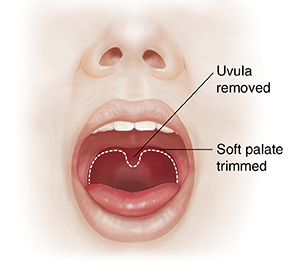Uvulopalatopharyngoplasty (UPPP)
Uvulopalatopharyngoplasty (UPPP)
Your healthcare provider has suggested uvulopalatopharyngoplasty (UPPP) to treat your snoring or sleep apnea (a condition that affects nighttime breathing). During UPPP, the tonsils and soft tissue in the back of the throat are removed. This helps prevent blockage of the airway during sleep. In many cases, UPPP can permanently improve sleep apnea and decrease snoring. Even so, you may need to continue other treatments such as CPAP (continuous positive air pressure) at first.
Preparing for surgery
Prepare for the surgery as you have been instructed. Be sure to tell your healthcare provider about all medicines you take. This includes over-the-counter drugs. It also includes herbs and other supplements. You may need to stop taking some or all of them before surgery as directed by your healthcare provider. Also, follow any directions you’re given for not eating or drinking before surgery.
The day of surgery
The surgery takes about 60 minutes. If you are having UPPP combined with nasal surgery, your experience will be slightly different than what is described here. In that case, your healthcare provider can tell you what to expect.
Before the surgery
Here's what to expect before the surgery begins:
An IV line is put into a vein in your arm or hand. This line delivers fluids and medicines.
You will be given medicine (anesthesia) to keep you free of pain during the surgery. This will likely be general anesthesia, which puts you into a state like deep sleep during the surgery.
During the surgery
Here's what to expect at the time of surgery:
A special device holds your mouth open. Pillows may be placed under your shoulders and on either side of your neck to support your head.
If you still have tonsils, these will likely be removed.
The soft tissue at the back of your mouth (soft palate) is trimmed. The small piece of flesh that hangs down from the soft palate (uvula) is removed.
The edges of the remaining tissue are closed with sutures (stitches). The sutures dissolve on their own in a few weeks.
You may have an injection of local anesthesia. This helps prevent pain after surgery.
Recovering in the hospital
After the surgery, you will be taken to a room to wake up from the anesthesia. At first, your throat will feel very sore. It will be hard to talk and swallow. You may also feel sleepy and nauseated. You will receive pain medicine. If you still feel pain, tell the healthcare provider or nurse. If you have sleep apnea, you will likely stay overnight in the hospital so your breathing can be closely watched. Once you are ready to go home, you will be released to an adult family member or friend.
Recovering at home
Once at home, follow the instructions you have been given. You will have throat pain as you recover. This may come and go. It’s normal for pain to increase few days after surgery, before it starts to improve. It may take around 3 weeks for the pain to go away completely. Eating and drinking will likely be uncomfortable for about 5 days. During your recovery:
Take all medicines as directed, including pain medicine.
Do not drive while you are on opioid or narcotic pain medicine. Expect to feel sleepy or dizzy while you are taking this medicine.
Drink lots of cold liquids. Water, noncitrus juices, and frozen juice bars are good choices.
Stick to cold foods and soft foods, which are easiest to swallow. Try ice cream, gelatin, eggs, pasta, and mashed potatoes. Avoid hot, spicy, acidic, hard, or crunchy foods.
Don't cough or clear your throat for 2 weeks.
Don't use ibuprofen or aspirin for 14 days after surgery, unless your healthcare provider says it’s OK. You may take acetaminophen as directed for pain.
Limit exercise as directed. Your healthcare provider will tell you when you can return to your normal activities and routine.
Follow instructions for when to start using continuous positive air pressure (CPAP) if it is prescribed.
When to call your healthcare provider
Be sure you have a contact number for your healthcare provider. After you get home, call if you have any of the following:
Chest pain or trouble breathing (call 911)
Fever of 100.4°F (38°C) or higher, or as directed by your healthcare provider
Bright red bleeding from the mouth or nose
Severe pain not relieved by medicine
Signs of dehydration (dark urine, urinating less often)
Heavy or persistent bleeding in the throat at any time
Inability to eat or drink at all for 2 to 3 days
Other signs or symptoms as indicated by your healthcare provider
Follow-up
During follow-up visits, your healthcare provider will check on your healing. A sleep study may be done a few months after surgery. This helps show whether your sleep apnea has improved. If you are still not sleeping normally, other treatments may be needed.
Risks and possible complications
Risks of UPPP include:
Bleeding, which may happen a week or more after the surgery (usually needs treatment)
Severe throat pain during the healing period
Changes in the sound of your voice
The feeling that something is stuck in your throat (may last 6 to 12 months)
Liquids going into the nose when swallowing
Failure to cure sleep apnea
Risks of anesthesia, including apnea. You will discuss these risks with the anesthesiologist.
Updated:
September 02, 2017
Sources:
Management of obstructive sleep apnea in adults. UpToDate, Tonsillectomy in adults. UpToDate
Reviewed By:
Blaivas, Allen J., DO,Dozier, Tennille, RN, BSN, RDMS,Image reviewed by StayWell medical illustration team.
